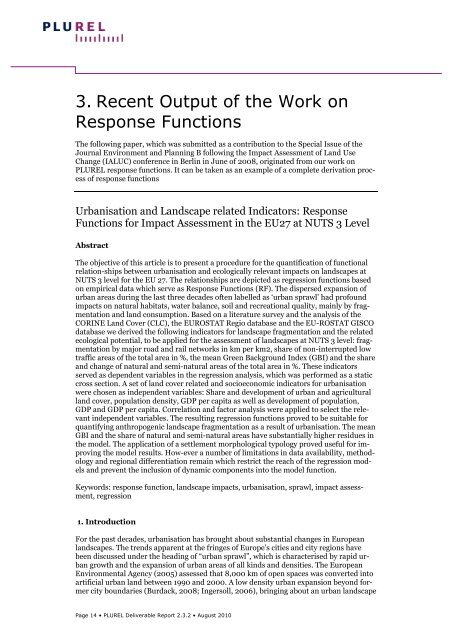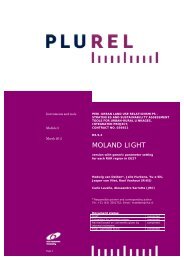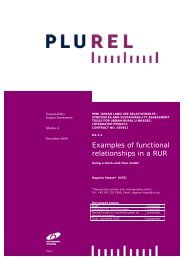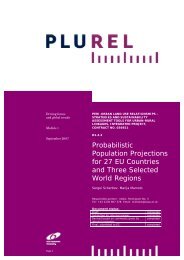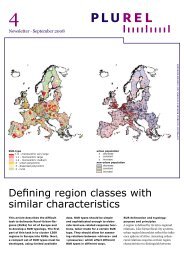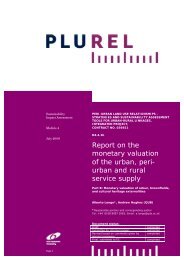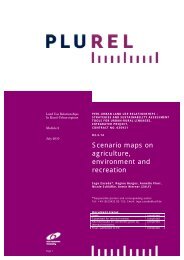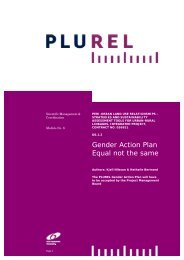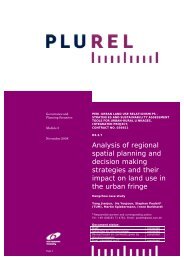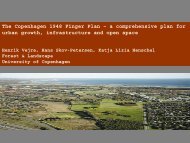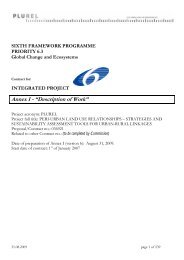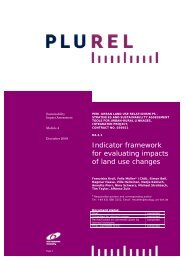Delination of response Functions - Plurel
Delination of response Functions - Plurel
Delination of response Functions - Plurel
- No tags were found...
Create successful ePaper yourself
Turn your PDF publications into a flip-book with our unique Google optimized e-Paper software.
3. Recent Output <strong>of</strong> the Work on<br />
Response <strong>Functions</strong><br />
The following paper, which was submitted as a contribution to the Special Issue <strong>of</strong> the<br />
Journal Environment and Planning B following the Impact Assessment <strong>of</strong> Land Use<br />
Change (IALUC) conference in Berlin in June <strong>of</strong> 2008, originated from our work on<br />
PLUREL <strong>response</strong> functions. It can be taken as an example <strong>of</strong> a complete derivation process<br />
<strong>of</strong> <strong>response</strong> functions<br />
Urbanisation and Landscape related Indicators: Response<br />
<strong>Functions</strong> for Impact Assessment in the EU27 at NUTS 3 Level<br />
Abstract<br />
The objective <strong>of</strong> this article is to present a procedure for the quantification <strong>of</strong> functional<br />
relation-ships between urbanisation and ecologically relevant impacts on landscapes at<br />
NUTS 3 level for the EU 27. The relationships are depicted as regression functions based<br />
on empirical data which serve as Response <strong>Functions</strong> (RF). The dispersed expansion <strong>of</strong><br />
urban areas during the last three decades <strong>of</strong>ten labelled as ‘urban sprawl’ had pr<strong>of</strong>ound<br />
impacts on natural habitats, water balance, soil and recreational quality, mainly by fragmentation<br />
and land consumption. Based on a literature survey and the analysis <strong>of</strong> the<br />
CORINE Land Cover (CLC), the EUROSTAT Regio database and the EU-ROSTAT GISCO<br />
database we derived the following indicators for landscape fragmentation and the related<br />
ecological potential, to be applied for the assessment <strong>of</strong> landscapes at NUTS 3 level: fragmentation<br />
by major road and rail networks in km per km2, share <strong>of</strong> non-interrupted low<br />
traffic areas <strong>of</strong> the total area in %, the mean Green Background Index (GBI) and the share<br />
and change <strong>of</strong> natural and semi-natural areas <strong>of</strong> the total area in %. These indicators<br />
served as dependent variables in the regression analysis, which was performed as a static<br />
cross section. A set <strong>of</strong> land cover related and socioeconomic indicators for urbanisation<br />
were chosen as independent variables: Share and development <strong>of</strong> urban and agricultural<br />
land cover, population density, GDP per capita as well as development <strong>of</strong> population,<br />
GDP and GDP per capita. Correlation and factor analysis were applied to select the relevant<br />
independent variables. The resulting regression functions proved to be suitable for<br />
quantifying anthropogenic landscape fragmentation as a result <strong>of</strong> urbanisation. The mean<br />
GBI and the share <strong>of</strong> natural and semi-natural areas have substantially higher residues in<br />
the model. The application <strong>of</strong> a settlement morphological typology proved useful for improving<br />
the model results. How-ever a number <strong>of</strong> limitations in data availability, methodology<br />
and regional differentiation remain which restrict the reach <strong>of</strong> the regression models<br />
and prevent the inclusion <strong>of</strong> dynamic components into the model function.<br />
Keywords: <strong>response</strong> function, landscape impacts, urbanisation, sprawl, impact assessment,<br />
regression<br />
1. Introduction<br />
For the past decades, urbanisation has brought about substantial changes in European<br />
landscapes. The trends apparent at the fringes <strong>of</strong> Europe’s cities and city regions have<br />
been discussed under the heading <strong>of</strong> “urban sprawl”, which is characterised by rapid urban<br />
growth and the expansion <strong>of</strong> urban areas <strong>of</strong> all kinds and densities. The European<br />
Environmental Agency (2005) assessed that 8,000 km <strong>of</strong> open spaces was converted into<br />
artificial urban land between 1990 and 2000. A low density urban expansion beyond former<br />
city boundaries (Burdack, 2008; Ingersoll, 2006), bringing about an urban landscape<br />
Page 14 • PLUREL Deliverable Report 2.3.2 • August 2010


